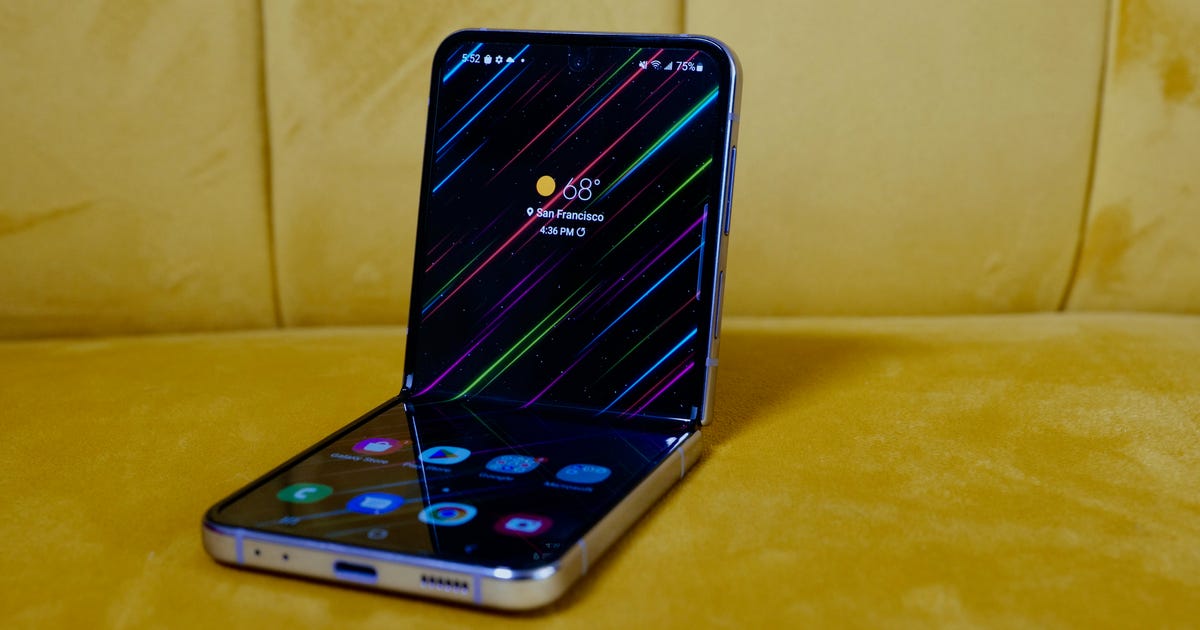
Galaxy Z Flip 4 Review: Pure Fun, but More of the Same
Samsung's Galaxy Z Flip 4 is the most tourism and fun phone I've tested this year. It's the "have your cake and eat it too" of smartphones. You can fold its slender, high refresh-rate, 6.7-inch cover in half, turning it into something the size of a current coaster that easily fits in most pockets.
The Z Flip 4 is also one of the best realizations of Samsung's folding shouted aesthetic to date. You can use it just like a ragged "candy bar" phone but get the added benefit of it intimates super portable as well as several special features that aren't counterfeit on other phones aside from its sibling the Z Fold 4.
Like
Fun foldable design
High refresh-rate cover looks good
Main camera takes good photos in medium and low light
Don't Like
Cover cover needs more functionality
Battery barely gets ended a day
Ultrawide and selfie cameras are just average
Price is high
The Flip 4 starts at $1,000. Most of that price is because it can fold in half, but it also packs one of the most distinguished and efficient processors found in any Samsung phone. That effect also gets you a robust build and something that most gadgets lack: personality. To quote Jules from Pulp Fiction, "Personality goes a long way."
Nearly everything near the Flip 4 feels fun and approachable, from its runt, squared-off footprint when it's closed to the fact that you can determine your own "bespoke" color scheme for it. But the same can be said near last year's Galaxy Z Flip 3, which Samsung remains to sell at a discounted price. I was hesitant to recommend the Flip 3 because its battery life wasn't immense and the cameras were just OK. And those caveats peaceful exist for last year's Flip even at its border $900 price.
Galaxy Z Flip 4 prices
Storage | US price | UK price | Australia price |
|---|---|---|---|
256GB | $1,000 | £999 | AU$1,499 |
512GB | $1,060 | £1,059 | AU$1,649 |
1TB | $1,180 | £1,199 | AU$1,849 |
The new Galaxy Z Flip 4 inherits all the good things from its predecessor and addresses most of the Flip 3's shortcomings. For over two weeks, I tested a review sample on loan from Samsung. While I appreciated all of the upgrades large and diminutive, Samsung could still go further, especially in terms of extending the battery life and improving the camera quality. I'd also like to see more functionality on the conceal display.
Still, the Galaxy Z Flip won't be truly ready for the masses pending it can reliably get through a long day on a single beak. The Flip 4 isn't there yet, but it's sketch close.
It's also worth a mention that, even thought the phone costs $1,000, Samsung and wireless carriers have been heavily funding the price, making it a bit more palatable for those who really want one.
Read more: Galaxy Z Fold 4 Review: Why I Can't Get Enough of Samsung's New Phone
The Z Flip 4's invent is fun and minimalistic
You'd be forgiven for confusing the Flip 3 and Flip 4. They are virtually identical, which is fine because the design works so well. The Flip 4 was upgraded with Gorilla Glass Victus Plus, aluminum sides, a more durable main screen and a minuscule increase in weight that adds up to the Flip 4 feeling solid. Though I'd never describe the phone as heavy. It has a nice, satisfyingly firm feel. I didn't need to baby it or usage it differently from any other phones I use.
It has an IPX8 including for water resistance, meaning it can be submerged up to 1.5 meters (about 5 feet) for 30 minutes. But as impressive as that is, the Flip 4 lacks dust resistance.
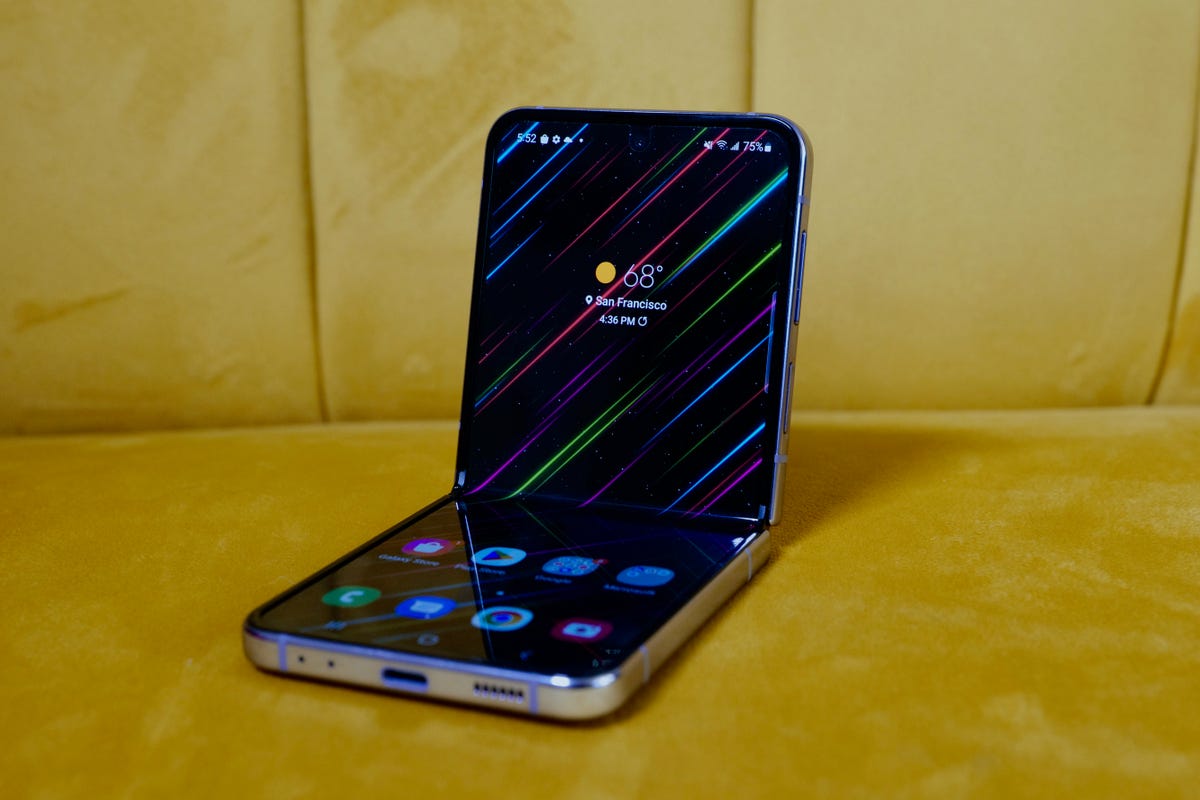
The new Galaxy Z Flip 4 looks nearly identical to last year's Z Flip 3.
Patrick Holland
The named has a new matte finish, which in purple doesn't show fingerprints. It's far better than the glossy finish on the Flip 3. I dig how the Flip 4's aluminum sides have a gleaming purple hue to them.
If you're wondering nearby the screen crease, it's still there. It doesn't bother me, but I get why some farmland might be put off by it. It's not that noticeable real you're likely to use the Flip 4, like any visited, head-on.
Read more:
Galaxy Z Flip 4 and Z Fold 4 Unboxing: What's in the Box
The Flip 4's indicate isn't laminated to a glass panel like a queer phone. There's just a minute layer that separates your finger from the high refresh rate cloak, and it feels like there is nothing between your fingertips and the internet -- or you and your photos.
This might seem silly to mention, but the Flip 4 is scrumptious to open and close. It takes a little time to get used to, but at what time a day or so I was able to flick it open one-handed, Captain Kirk style. The closing sound is ridiculously gratifying and adds to that "personality" I mentioned backbone. These are the details you're paying $1,000 for.
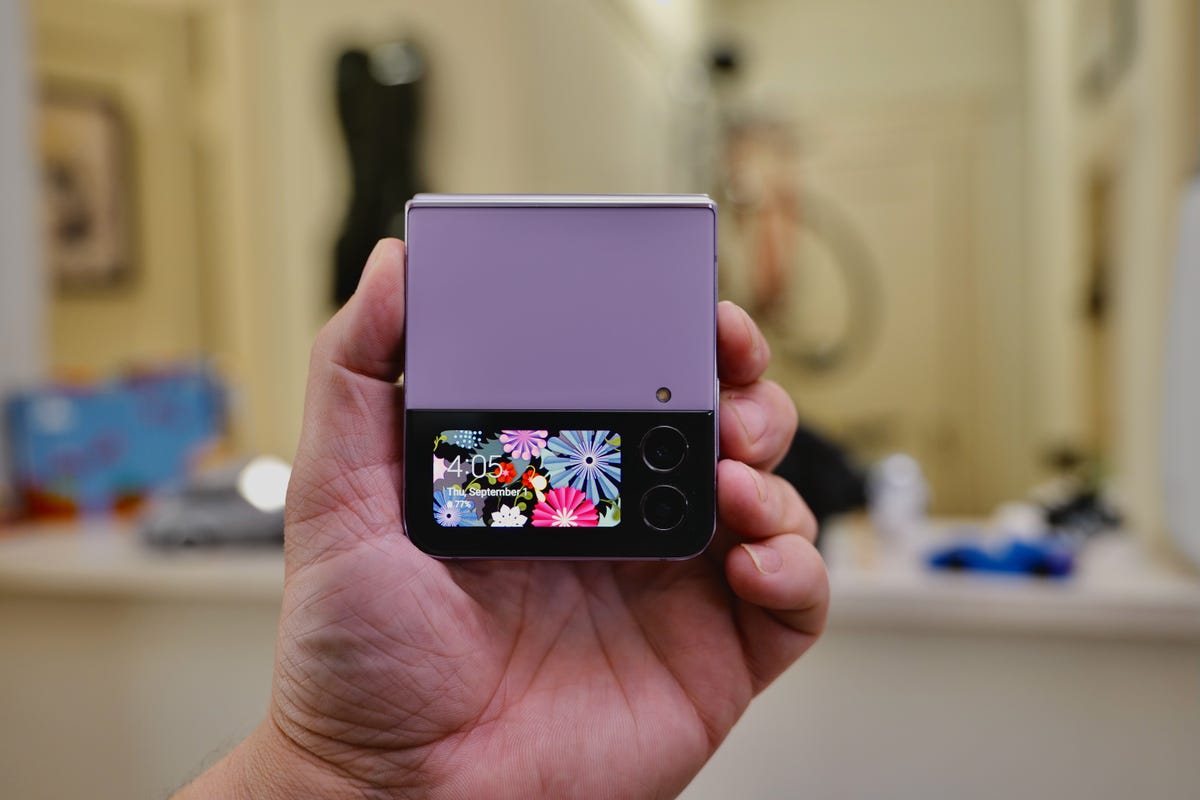
The camouflage screen is identical to the one on the Galaxy Z Flip 3.
Patrick Holland
The minor cover screen that tried
On the outside of the Flip 4 is a exiguous cover display that's the same size as the one on the Flip 3. In periods of functionality, it's largely the same as well. I wish it did more.
You can now send canned responses to hazardous messaging apps directly from the cover display. But there isn't an option to type or dictate a retort without opening up the phone. Of everything on the Flip 4, the camouflage screen is the place where Samsung could do more.
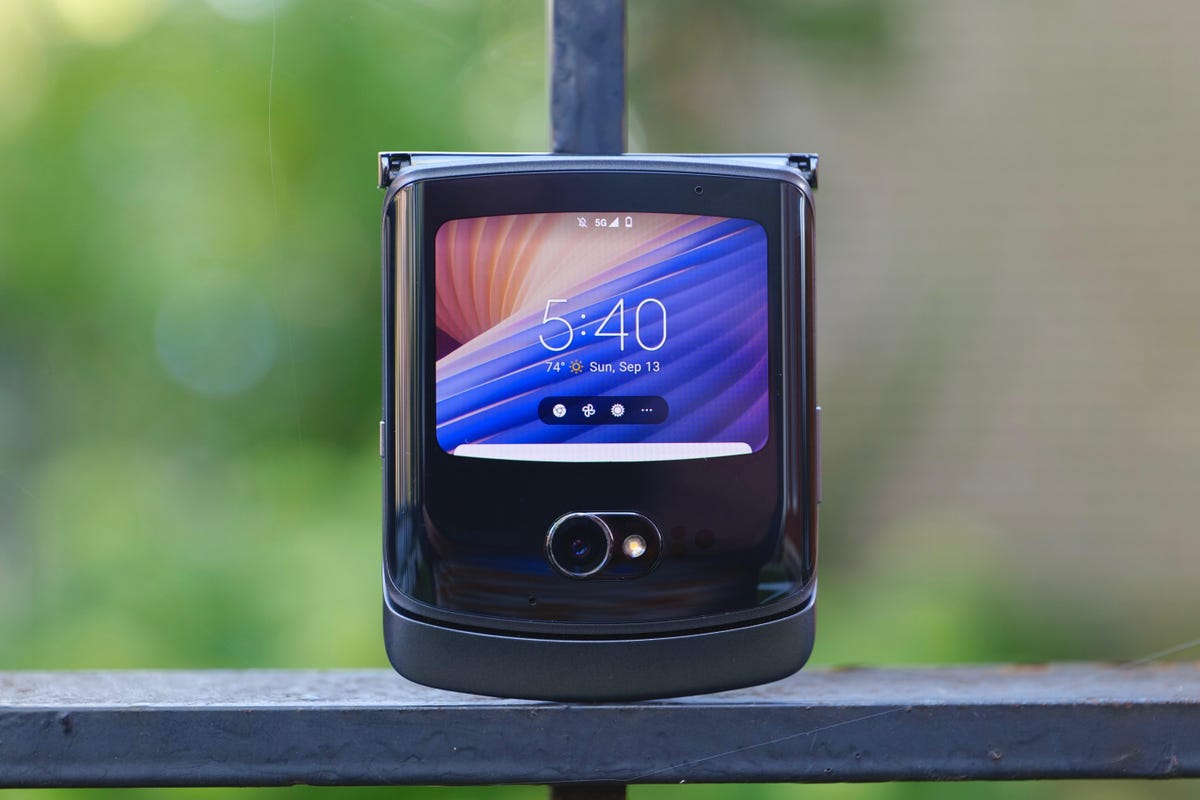
The exterior demonstrate on the Motorola Razr (2020) is larger and has far more functionality than the Z Flip 4.
Patrick Holland
When I reviewed the 2020 Motorola Razr, its external display really opened my eyes to what was possible. I was able to use the Razr's Quick View demonstrate as a tiny Android phone. I even got video games like PUBG Mobile to work on the external demonstrate.
To be clear, I don't need to play Call of Duty on the Flip 4's veil display. But how about a smartwatch-like keyboard for replies? Or maybe a larger veil display? There's a lot of space to extend the recent one.
Then there's Flex Mode, which triggers software to sulky when the Flip 4 is positioned halfway open. App blissful moves to the top half and tools and settings are at the bottom. There are more apps optimized for Flex Mode, like Instagram and Samsung's own Gallery app which now lets you edit a photo in Flex Mode while keeping the report on the top half of the screen. Flex Mode on survive Flips and Folds awkwardly moved the photo to the middle.
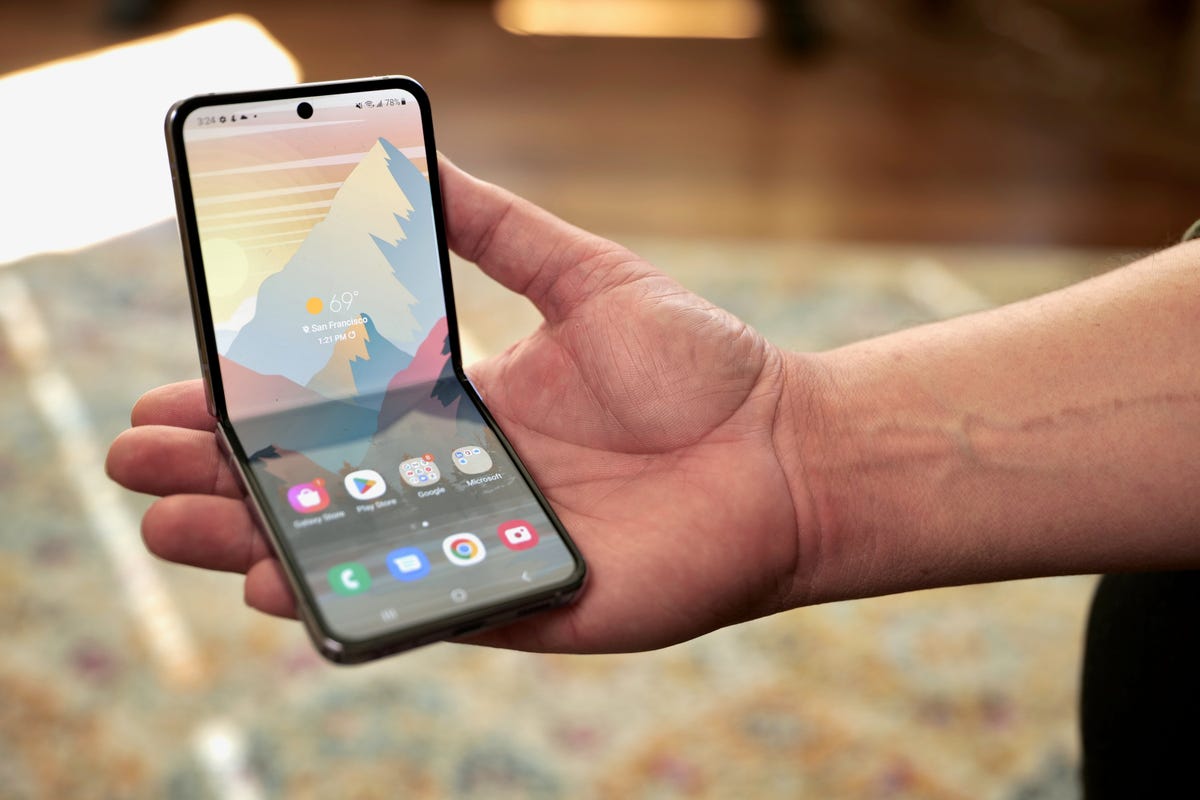
The Galaxy Z Flip 4's hinge gives it to stay at various angles. When it's halt to perpendicular it can activate Flex Mode for the software.
Patrick Holland
Most apps aren't optimized for Flex Mode but Samsung has a creative workaround in Settings named Labs that lets you force any app into Flex Mode. Usually that employing the app moves to the top half and Samsung's default Flex Mode interface is on the bottom. So technically it works, but it doesn't really do much.
The big new transfer to Flex Mode is that it gets a trackpad and tiny cursor. You can click buttons and open menus with the world's tiniest cursor, or use two fingers to swipe and move about like exploring street view in Google Maps. This trackpad seems like a New idea, but in actual use it's not very practical.
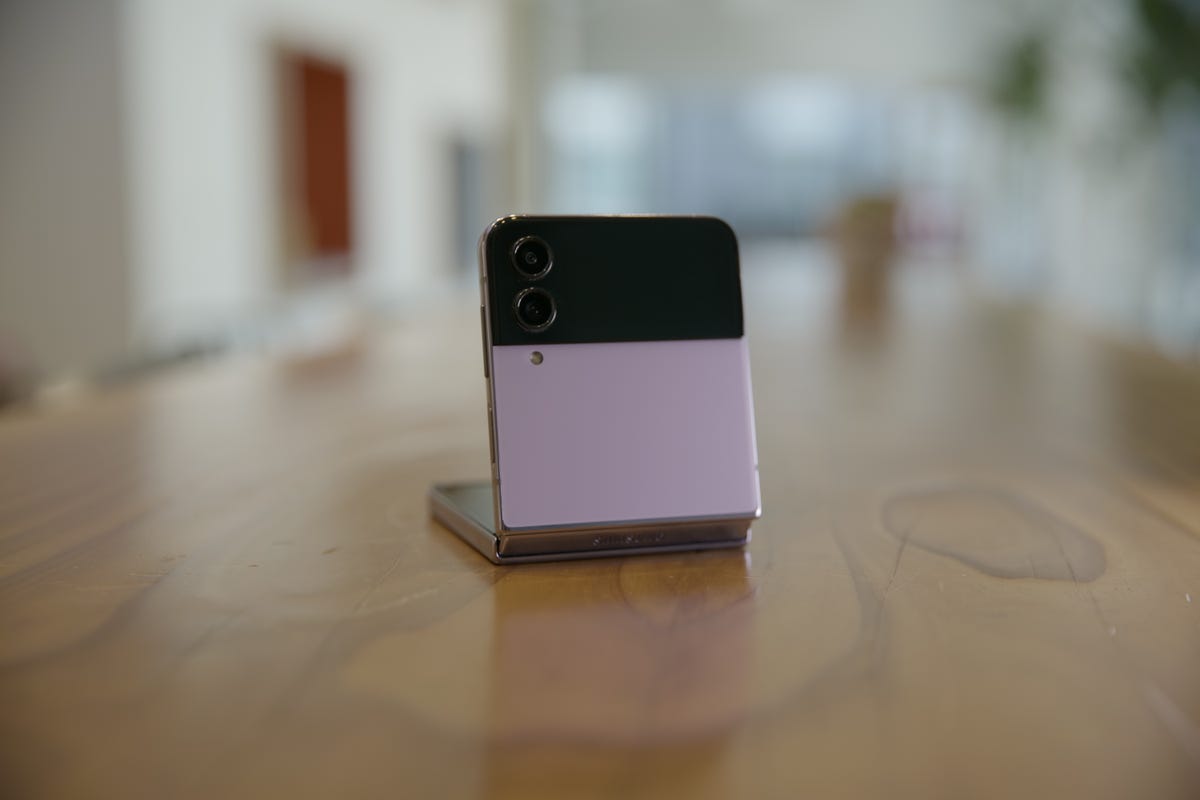
There are two exterior cameras on the Flip 4: a main wide-angle and an ultrawide.
John Kim
A small camera upgrade but major versatility
The Flip 4 has the same selfie and ultrawide cameras that are involved on the Flip 3. The main camera gets a new image sensor which, like the battery, gives photos a boost in image quality, but nothing major.
Photos from the Flip 4 have a nice, punchy look in footings of contrast and color. For some, the way the Flip 4 processes colors Great look over-saturated.
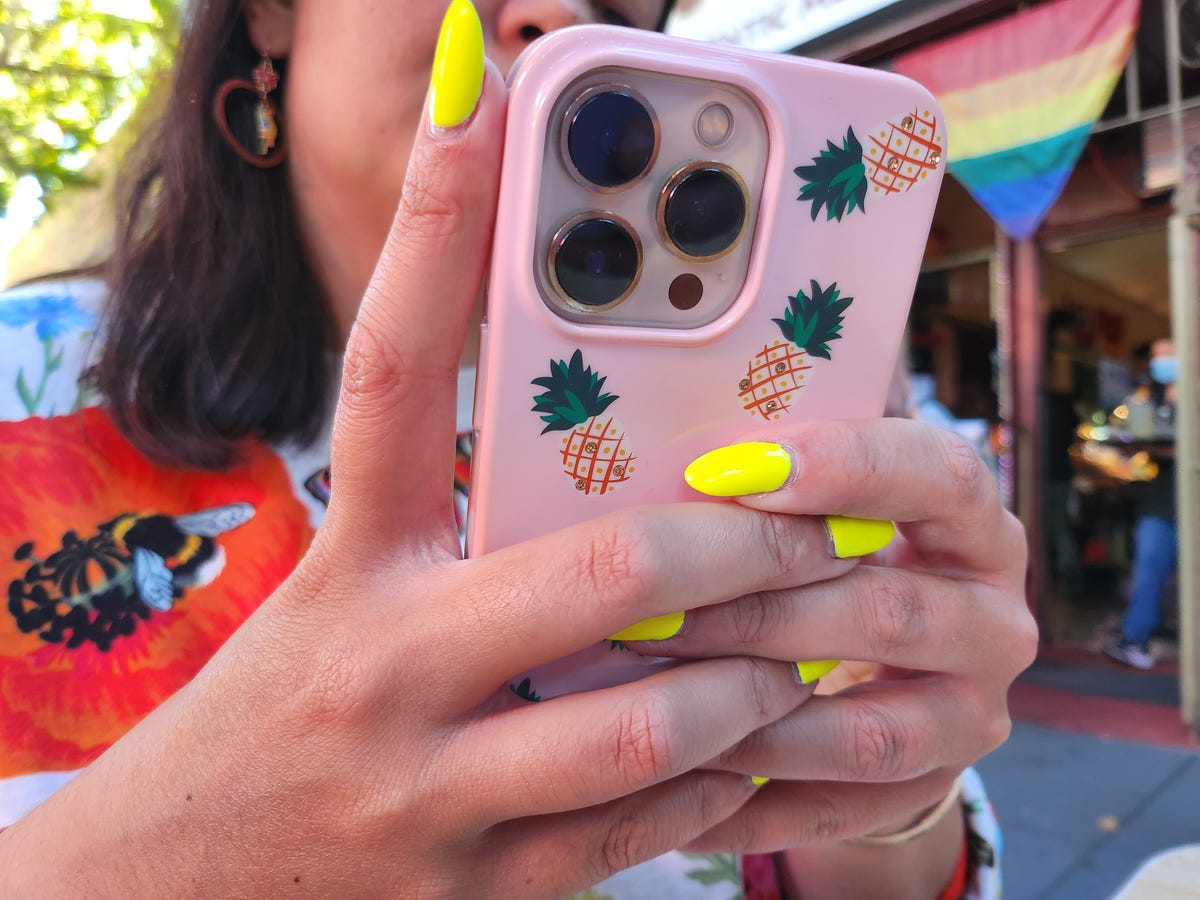
Here is a titanic example of how the Flip 4 renders colors. It straddles the line between selves saturated and oversaturated.
Patrick Holland
Surprisingly, that new main sensor comes into its own when taking photos in low-light calls. Photos have nice detail and not a lot of image noise sad you're zoomed in. The Flip 4 doesn't have a failed telephoto camera, and that means you rely entirely on digital zoom, which is where the image starts to fall apart.

This mighty be one of my favorite photos from the Flip 4. The dynamic way and details look good.
Patrick Holland

A portrait mode pic of Maisie the cat.
Patrick Holland

I used the Flip 4 positioned in an L-shape to grab this snap of some gnocchi I was cooking.
Patrick Holland
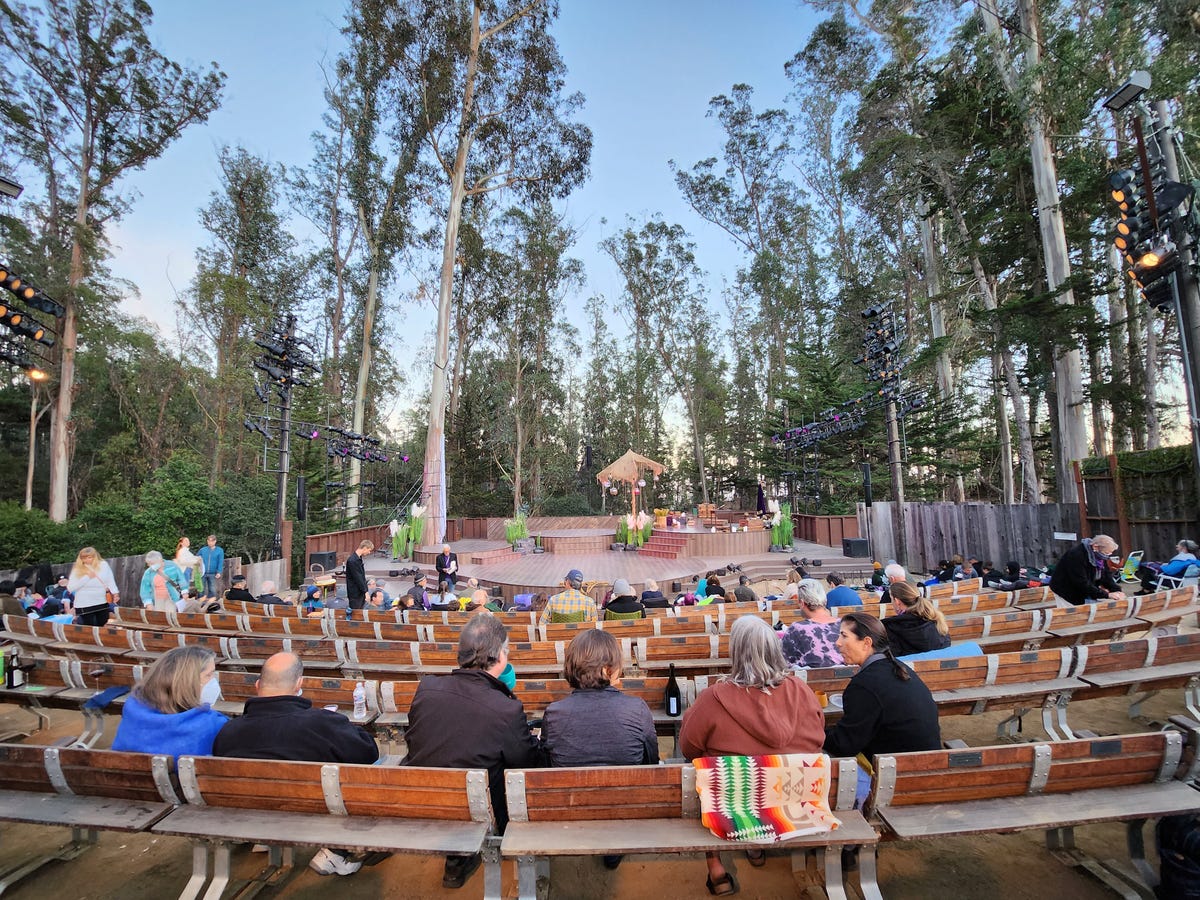
This was unsuitable with the ultrawide camera. In good lighting, you can get some obscene photos with it.
Patrick Holland
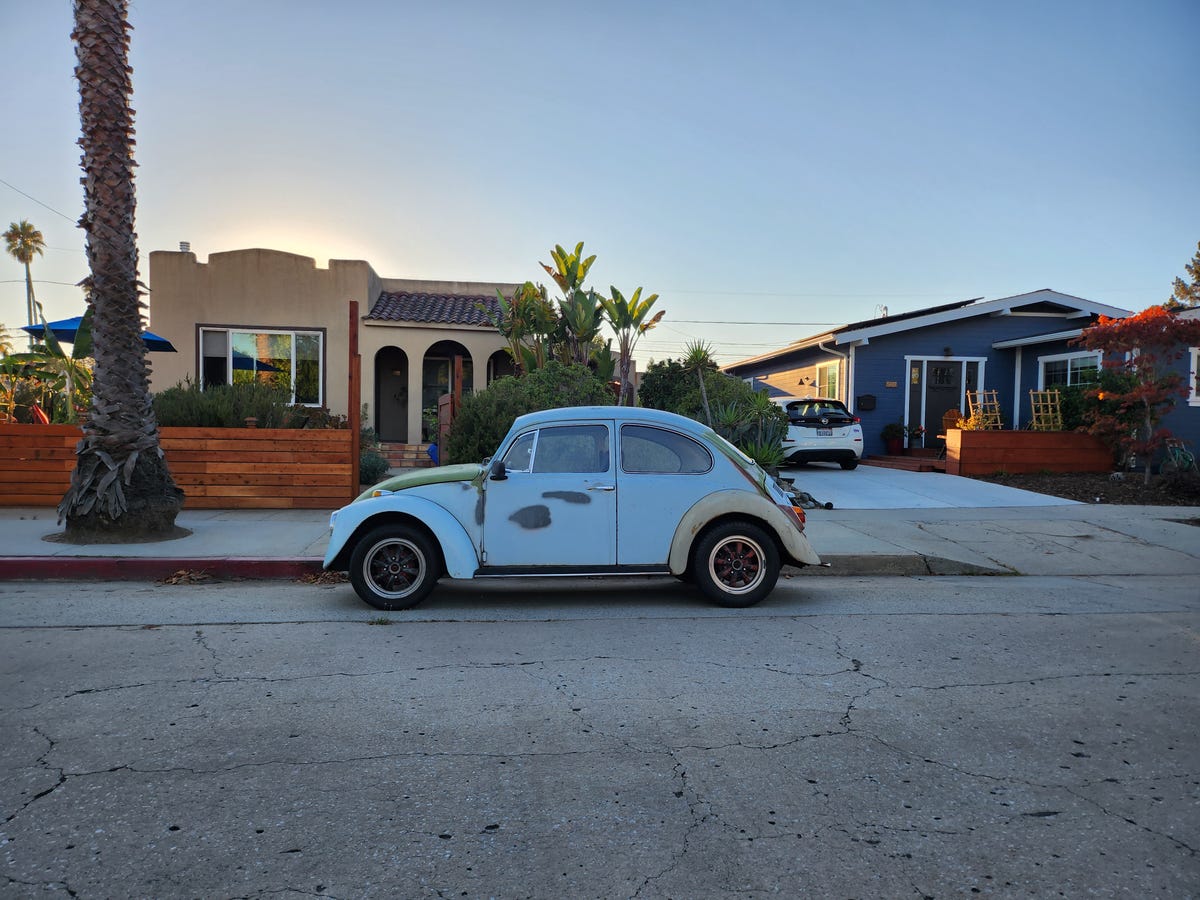
I dig the way the Flip 4 captured this old VW bug, especially the subtle differences in the car's blue and the sky.
Patrick Holland
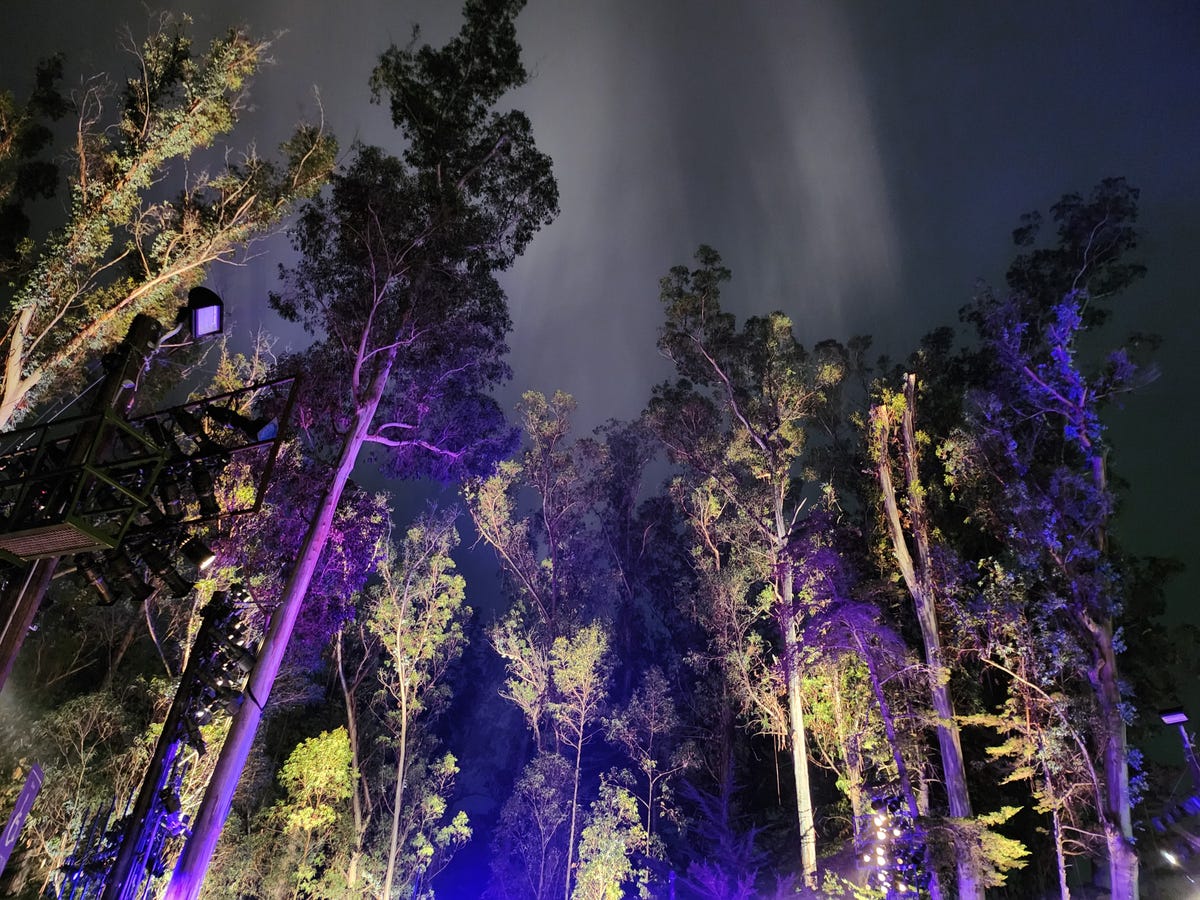
This is a night mode photo of some eucalyptus trees lit with colored lights.
Patrick Holland

I took this selfie humorous the main rear camera. The camera's preview can show on the mask display to help with framing.
Patrick Holland
Despite having B-grade cameras, the Flip 4 gives you one of the most versatile camera setups on any arranged. The fact that it can fold and hold its dwelling means you're able to put the phone nearly anywhere and dwelling it at a bunch of different angles. I was able to grab a video of my cat playing at her eye collected and capture some snazzy shots of a pan of cooking gnocchi because the Flip 4 is its own tripod.
And one small upgrade with mighty ramifications is that the screen display can now show a full preview of either portrait or landscape photos and videos. Previous Flips severely cropped the camera preview on the screen display making it a challenge to frame group selfies. The new preview functionality and the ability to trigger the camera shutter by holding your hand up benefitting the Flip 4 could be one of the best creative tools for capturing social consider content.
A diminutive increase in battery life
The Flip 4's larger battery and new Snapdragon 8 Plus Gen 1 chip, which increases efficiency, translates to a tiny bit longer battery life. Nonetheless, the difference isn't game-changing. On the Flip 3, I erroneous myself making it to the late-afternoon before it obligatory to be charged. With the Flip 4, I typically made it throughout a day. But if I used my phone heavily to view videos, take photos or have a video call, that battery lasted me pending early evening at best.
I definitely won't scoff at unsheathing a couple more hours on a single charge. The Flip 4's better battery life establishes it less of a compromise for someone coming from a nonfolding arranged. But it's still something to consider.
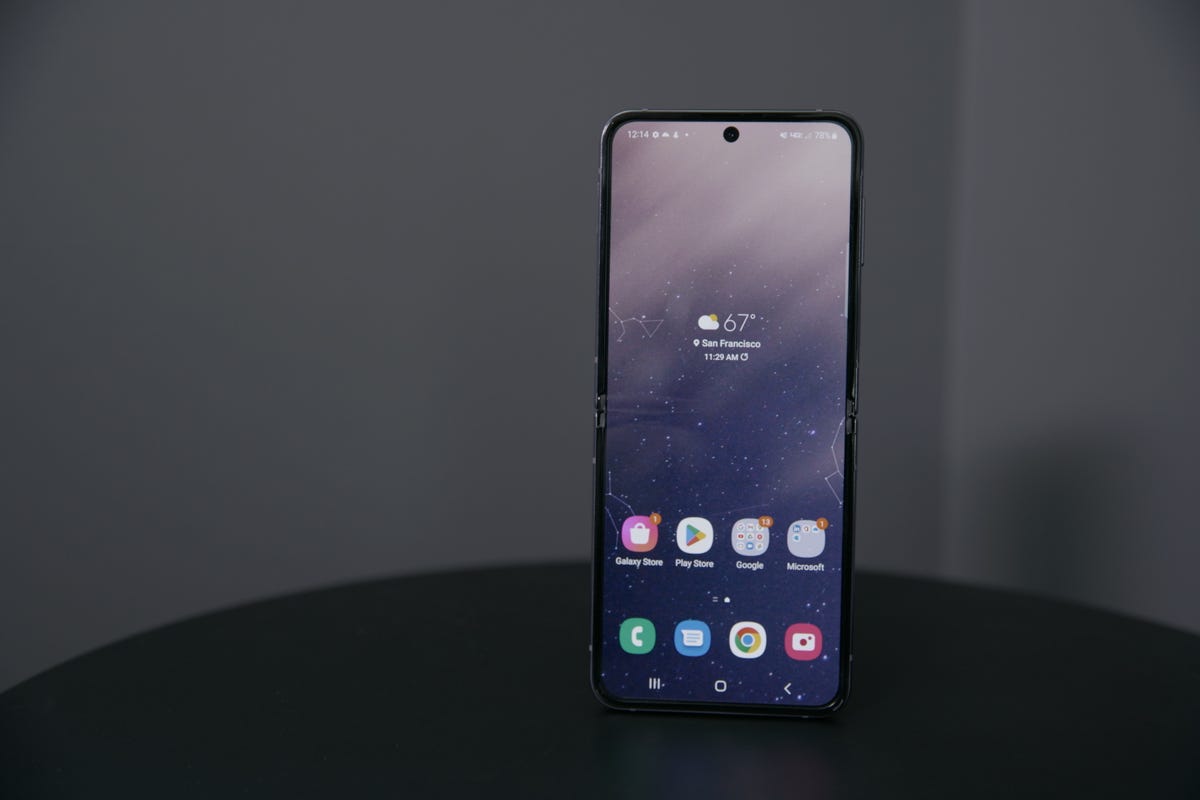
The Galaxy Z Flip 4 and Fold 4 are the most grand phones Samsung currently sells.
Patrick Holland
Over 45 minutes with the camouflage at full brightness, I watched a couple of YouTube videos, scrolled my Instagram feed, played a bout of PUBG Mobile, then raced a circuit in Mario Kart Tour, took a 5-minute video call via Zoom and, lastly, played Alto's Odyssey. The battery went from 70% to 56%.
The new processor and Android 12L make the Flip 4 feel peppy and responsive. Animations look smooth and gaming is fun. Multitasking between two apps in quickly screen runs well. And the performance was impressive, especially when it came to benchmark complains which allows us to compare the performance of one arranged against another. The Flip 4 performed better than last year's Flip 3 and even the Galaxy S22.
Geekbench V.5.0 single-core
Samsung Galaxy Z Flip 4
Samsung Galaxy Z Flip 3
Note:
Longer bars point to better performance
Geekbench V.5.0 multicore
Samsung Galaxy Z Flip 4
Samsung Galaxy Z Flip 3
Note:
Longer bars point to better performance
3DMark Slingshot Unlimited
Samsung Galaxy Z Flip 4
Samsung Galaxy Z Flip 3
Note:
Longer bars point to better performance
Flip 4 vs. Flip 3 vs. Flip 5G vs. S22
If you're a original Flip 3 user, should you upgrade? I wouldn't. I don't think you get enough "new" on the Flip 4 to warrant a year-over-year upgrade. If you're trying to decide between getting a Flip 4 or a discounted Flip 3, that's a tougher conundrum. I'd probably push you to get the Flip 3 and save cash.
If you have an original Flip or a Flip 5G, I do think upgrading is honorable it, especially if you can snag one of those hefty trade-in discounts. You get a more robust build with water resistance, a bigger battery, a larger cover screen, a faster and more efficient processor and a high-refresh-rate main demonstrate.
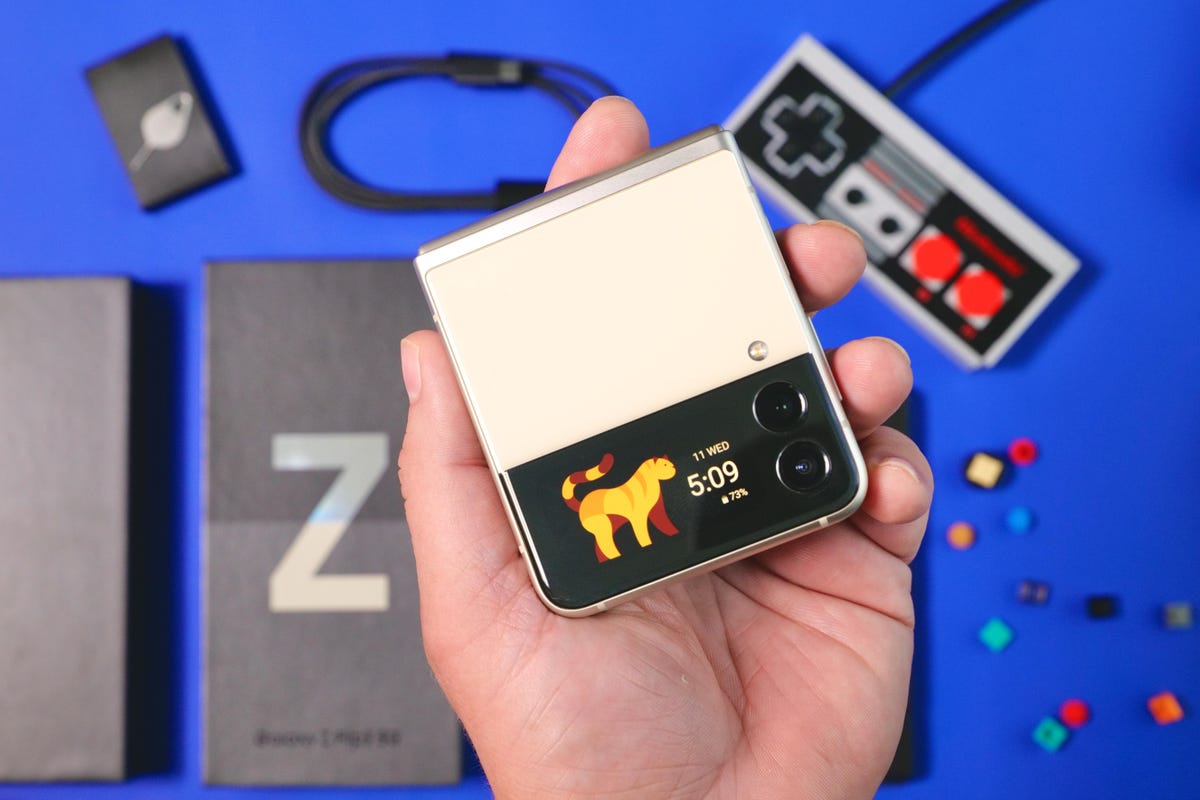
The Flip 3 and Flip 4 are hard to tell apart. But the Flip 3 cost a little less.
Patrick Holland
If you're deciding between a Flip 4 and a Galaxy S22, your select really comes down to whether you want a named that folds or not. You're really paying $200 more for that capability. While the Flip 4 has a faster processor, the Galaxy S22's battery lasts longer on a single promote.
At the end of the day, the Galaxy Z Flip 4 is a toothsome reminder that an innovative design that balances form, acting and fun goes a long way. And while all the upgrades are a step in the quick-witted direction, the Flip 4 still comes up short at basics like battery life and photography.
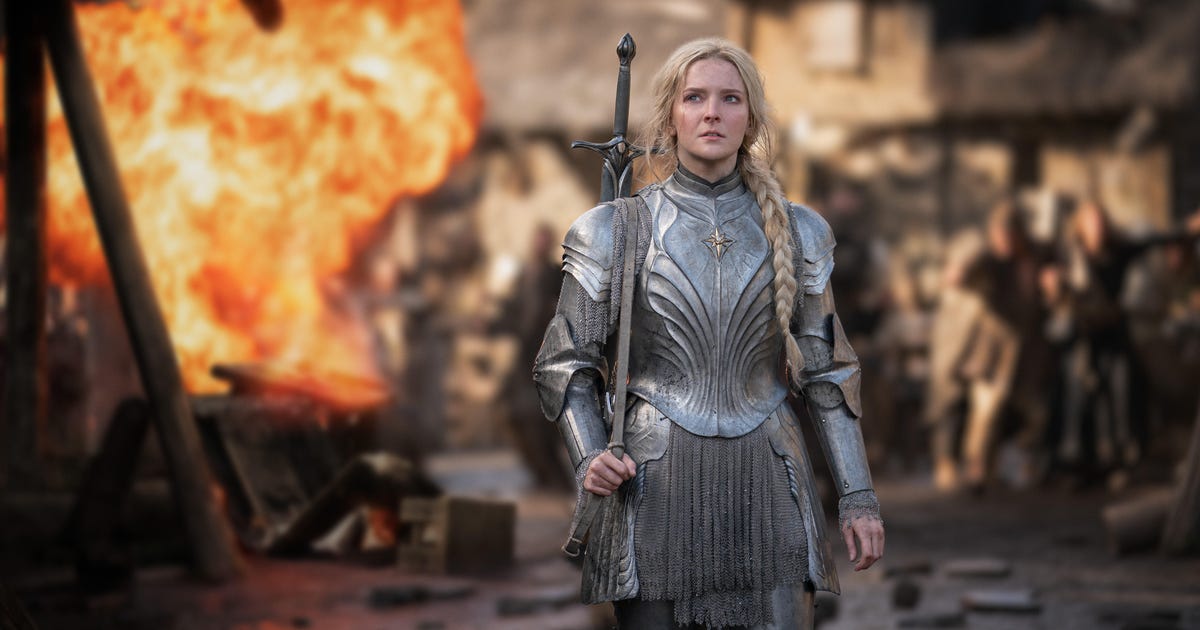
'The Rings of Power' Review: A Familiar, Epic Middle-Earth Adventure
The new Lord of the Rings TV show The Rings of Power takes you somewhere you've been before.
Among the many ununcommon elements in the Prime Video series coming Sept. 2 is the dwarf stronghold of Khazad-dûm. If you've watched Peter Jackson's classic Lord of the Rings film trilogy, you've visited Khazad-dûm as a terrifying tomb littered with skeletons, festooned with cobwebs and policed by a particularly substandard fire demon.
Now, long before Gandalf slipped off the edge of a smashed stone bridge, Khazad-dûm is a bustling kingdom where giant mirrors deem light into its depths, vibrant greenery flourishes, and countless dwarves speed about. Two decades after Jackson first took us to Middle-earth, The Rings of Power presents something familiar, but freshened up enough to make the shouted worthwhile for established fans and Tolkien newbies.
This is the challenge The Rings of Power faces. In the last 20 years, The Lord of the Rings trilogy has ingrained itself in mainstream pop culture -- from memes near not simply walking into Mordor, to Gollum impressions. Some never left Middle-earth, but for others, it's a question of whether a in backward is wanted or justified.
To borrow a quote from Galadriel in The Fellowship of the Ring, The Rings of Power seems to conception that its quest stands upon the edge of a knife. Judging from screeners of the first two episodes devoted by Prime Video, The Rings of Power makes a exact return to Middle-earth, offering all the things that endeared the originals to so many of us those many existences ago: the breathtaking vistas, the latex prosthetics and even the occasional bouts of ponderous dialogue published to some point on the horizon.
The Rings of Power takes assign in the Second Age of Middle-earth, thousands of existences before Frodo and friends ever thought about leaving the Shire. The series focuses on the forging of the substandard nine rings, and the evil Sauron's earlier, mayhem-inducing run. Thanks to the longevity of intimates, Galadriel (played by Morfydd Clark) and Elrond (Robert Aramayo) in backward as characters, accompanied by a host of new intimates, dwarves, men and Harfoots (short-statured ancestors of Hobbits), all experiencing that sinking feeling something wicked is afoot, and the accompanying denial.
Rings of Power successfully balances the way it invents itself accessible to newcomers, fans of the movies, and more intense lore fiends. (Though it remains to be seen how much the liberties it does take with Tolkien's work piss off the harder-core crowd.) If Fëanor and his hammer or Aulë and his beard don't mean anything to you, that's completely survivable.

Rings of Power cmoneys plenty of sweeping vistas.
Prime Video
The series adopts the visual style of the movies. The first two episodes alone serve up a feast of sweeping shots over snowy mountains, open plains and painfully gorgeous elven architecture. Rings of Power uses the same kind of shimmering grading that makes both Rivendell and the newly introduced Lindon glow golden, but the realms of men feel more gray.
The accumulate, too, composed this time around by Bear McCreary instead of Howard Shore, covers familiar territory. The soaring choral pieces can be ethereal or menacing, depending on the scene.
And there are some callbacks for sure, like opening with a prologue voiced over by Galadriel, or a tense moment with some bubbles in a lake, but Rings of Power restrains itself from unsheathing into the kind of cringing fan service that could only cheapen it. Instead, these elements do a lot of heavy lifting in settling the viewer into this complex story.
As for the new crop of Middle-earth inhabitants, though Cate Blanchett is hard to top, Clark establishes for a convincing prior incarnation, clear-eyed and battle-ready no custom who implores her to cool off. A run-in with a snow arranged is enough to turn her into a certified allotment hero. Dwarven Durin and his wife Disa provide some warmth and comical relief, not unlike Gimli in the trilogy, which is a welcome breath, tonally.
A big test for Rings of Power, plan, is how it paces itself while navigating at least four or five plot arrange. Somehow, a spunky young Harfoot named Nori finding a mysterious giant in a smoking crater has to be as listless as a romance of questionable chemistry between human Bronwyn (Nazanin Boniadi) and wearisome elf Arondir (Ismael Cruz Cordova). The danger is defending up with a work that looks, sounds and feels as stunning as any big-screen opus, but without the concentrated story to succor it.
And, of course, the series will also have to quarrel with a familiar issue among prequels: The fights between good and evil won't culminate in the kind of victory that's helped to make LOTR a pop culture glum food through uncertain times. No matter how the show unfolds over the next five seasons, Sauron will be back.
When The Fellowship of the Rings came out in 2001, it kick-started an era in which fantasy movies could be good with a capital G. When audiences examined an army of 10,000 orcs amass outside Helm's Deep, that was a visual feat, entirely new.
Twenty days later, audiences are used to spectacular fantasy worlds and big-screen fights not only in movies like Avengers: Infinity War and Endgame, but also in television shows like Game of Thrones, and now GOT's prequel series, House of the Dragon.
With so many anunexperienced universes to get immersed in, it's an open query whether throwing a billion or so dollars at an adaptation of a book's appendices over a minimum of five seasons is enough to delve into the glum of LOTR fandom.
But for now The Rings of Power is a cinematic trip back to Middle-earth that'll make you want to volunteer your axe with a hearty "why not?"
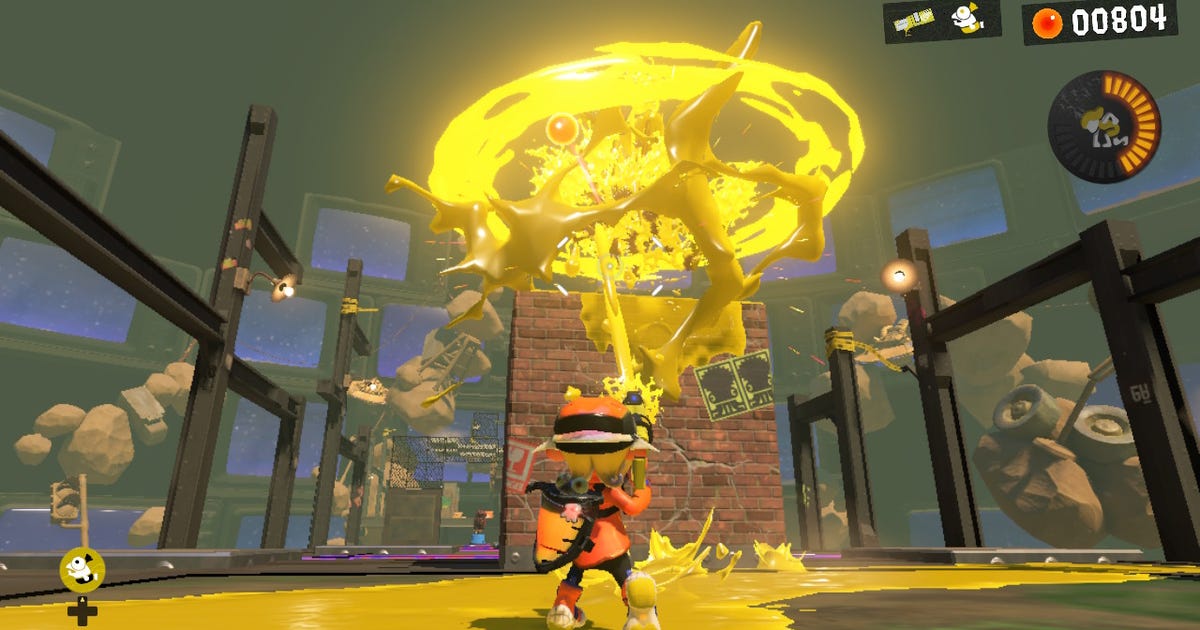
Splatoon 3 Review In Progress: Do You Need It Over Splatoon 2?
My 9-year-old told me he already wants to buy it. But he's unexcited playing Splatoon 2, happily ranking up, while I play bits of Splatoon 3 quick-witted next to him. One of Nintendo's biggest in-house Switch games of the holidays this year is a sequel that isn't necessarily something you need to buy. It feels like a new season of a beloved impish, as opposed to a whole new sport.
Too soon, I almost wondered? No way: Splatoon 2 came out five days ago, which kind of shocked me. But in Nintendo days, Splatoon 3 feels early. Mario Kart 8 has lived in repeating iterations dependable it emerged on the Wii U eight years ago (and unexcited sells for $45), although new tracks have kept it alive. Splatoon 2 could plainly have taken that path instead, launching new DLC frankly that could have let it live on for days more. But, Splatoon 3 is here, regardless. (It goes on sale this Friday, Sept. 9.)
What I'm saying is that Splatoon 2 is unexcited a really great game, and playing Splatoon 3 doesn't really feel all that tremendously different. Multiplayer battles have largely the same mechanics, with a few new goes, new weapons and new stages. Turf War, the classic argues where your percentage of the paint-splattered stage determines the win, is unexcited wonderful, and still similar. Anarchy Battles (which I didn't get to try yet prerelease; my online connection carried up) have four different modes to lend more esports flavor to the competition. Salmon Run, a co-op survival game against waves of enemies, is now an always-available mode instead of the sometimes-around oddity it was on Splatoon 2.

Tableturf Battle: I want to play this as an apt board game.
Nintendo/Screenshot by Scott Stein
There's also a tiny and fun collectible card game in Splatoon 3 that I'm weirdly into, named Tableturf Battle. Card-weapons become Tetris-like blocks you lay onto a grid to stammer territory in a turn-based battle. It's almost like the embarking game Blokus in Nintendo card form (and I'd buy it as a embarking game, too, if it existed).
A lot of the spanking extras in Splatoon 3 are collectibles -- there are a ton, floor with lockers that can be laid out to show off possessions to friends, but the customization game isn't always for me.
I'm a unpleasant online team player, and lousy at shooters. Splatoon is forgiving enough that I can feel like a nonfailure, sometimes, while still relentless enough to make me feel like I have a lot of work to do. It's unexcited maybe my favorite thing about the game.
There are a few Splatoon alternatives now for competitive team gaming on the Switch, many of them free to play, like Knockout City and Fall Guys. There's also Mario Kart 8 Deluxe, Super Smash Bros. and Mario Strikers: Battle League. Splatoon's quick matches win me over, especially when the chaos and strategy seem to balance just right.
Read more: Best Games on Nintendo Switch
The weirdest part of Splatoon 3 is its story mode, which I didn't know would be an exploration of how humankind became extinct and intelligent squid-octopus creatures ruled this game universe. I wasn't craving an origin story for Splatoon, but I love it. It's as surprising as Kirby and the Forgotten Land's apocalyptic inaugurate story. (What's with Nintendo's year of subtly dark cute post-apocalypse games?) I daren't fraction any more spoilers, though: Like previous games' single-player frankly, it's a fun mix of gameplay tutorial and puzzle-solving action.
As CNET's Sean Keane distinguished when he played Splatoon 3 at an early hands-on continue, a lot of the new game's features are so subtle that you much need to play a lot to appreciate them. I would have loved some bolder attempts. A big new idea that I love is the three-team SplatFest, which ends in a three-color turf war. But that's only for special actions, alas (one of which just wrapped up as a free demo session). I'd love if Nintendo explored this idea in the rest of Splatoon 3, opening up the concepts for the gameplay even further. What if you could have turf wars with four, five or six colors? Madness, you may say. I'd like to see the rainbow.

The Tri-Stringer Bow, one of a number of new weapons that do surprising things with ink.
Nintendo
While Splatoon 3 doesn't quite feel like a huge leap forward compared to Splatoon 2, it's also probable to be the game most Splatooners will be panicked on this fall. Considering Nintendo doesn't currently have that many new big games to come this year (other than Bayonetta 3 and Pokemon Scarlet and Violet, that is), this might be the place to be if you're looking for the next must-have online multiplayer hit. But, at $60, it'll be unslow to see how many Switch gamers just decide to play Splatoon 2 instead. The same-but-different feel reminds me of many Madden football updates of ages past, in some ways. At least, in this case, it's been five years.
Nintendo is promising more updates, including new weapons and stages, and some sort of paid DLC that could mirror the expansion that hit Splatoon 2.
But Splatoon 3 peaceful doesn't have the one feature my kid wants most of all: a split-screen co-op mode so I can play with him on the same TV with only one copy of the game. I'll need to buy a additional copy for that for his Switch, or hope Nintendo enables this as an update someday (hint, hint, Nintendo).
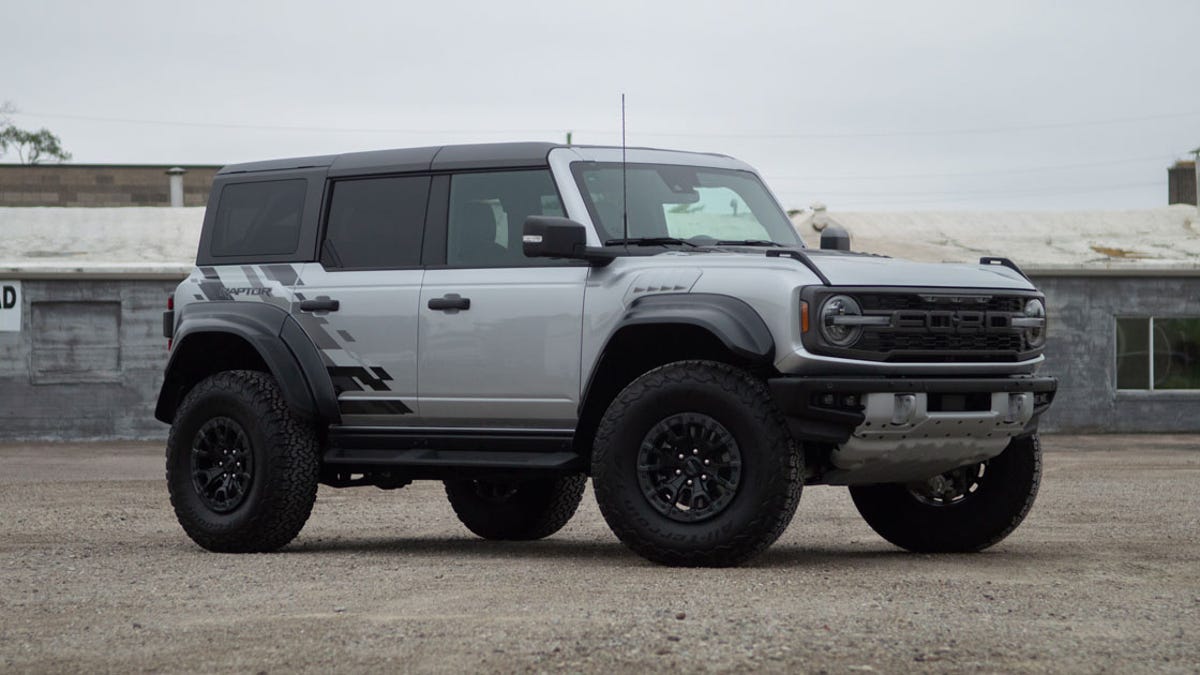
2022 Ford Bronco Raptor Review: The Unstoppable Force
The Ford Bronco is an eminently Good SUV that's impressive off-road without feeling like a hot mess on the pavement. But there's always room for a little more -- or, in the case of the Bronco Raptor, a lot more.
Three amber ftrips in the middle of the grille are all you need to see to know the Raptor is no Amazing Bronco. Those lights are required on vehicles of a Dangerous width, and the Bronco Raptor's body is about 10 inches wider than the Bad SUV. It practically blots out the sun as it sails down the road, casting one seriously imposing Dark. Of course, that also means it's practically the size of a highway lane, and even with Bad lane-keep assist, it takes a conscious effort to keep one of those 37-inch BF Goodrich K02 all-terrain plain from dipping over the dashed white lines. Thankfully, when it's time to park this brute, standard parking sensors and a surround-view camera make it easy to maneuver.
Despite its size, the Bronco Raptor is every bit as easy to right on-road as its smaller siblings. The off-road-ready Fox shocks subsidizes more than a foot of travel when it's time to hit a jump or traverse some rocks, but it doesn't make the Raptor bounce around carelessly on the highway. Even without switching the damping stiffness to Sport, the Raptor is nicely unexcited in daily driving, transferring only a few jostles from the road to the cabin. The steering weight is also adjustable, and while it's generally resplendent direct, I find it a bit too loosey-goosey in its most-boosted Comfort setting.
The Raptor's twin-turbocharged 3.0-liter V6 provides a meaty 418 horsepower and 440 pound-feet of torque, and combined with a quick-shifting 10-speed automatic, I'm certainly not lacking for motive managed. The Bronco may not have the full-fat output of the 450-hp F-150 Raptor, but the V6 offers more than enough power to blast past traffic and get up to speeds that crop me scrambling to remember what the tires are exaspearoused for. The V6 sounds great through a standard multimode consume, which I constantly leave in its loudest Baja setting, even though the dashboard screen constantly reminds me that it's for off-road use only. (I won't tell anyone if you don't.)
Besides, a loud exhaust is a great reminder that I am absolutely destroying gasoline in the flows of my enjoyment. The EPA rates the Ford Bronco Raptor at 15 mpg city and 16 mpg highway, numbers that I would certainly call possible, but if you're like me and you toothsome noise and using more than 10% of the throttle, expect something lower.
Inside, the Bronco Raptor provides plenty of livability -- and let's be unprejudiced, it needs to, since a hefty chunk of these brutes will more often find themselves traversing asphalt than Appalachians. Ford's comfortable marine-grade vinyl seats are standard, but my tester picks up $2,495 leather-trimmed replacements. Further zhuzhing up the cabin is a $1,725 carbon fiber trim pack, as well as the $2,695 Lux Package, which adds a heated steering wheel, a 10-speaker audio controls, dashboard-mounted USB ports, wireless device charging, adaptive cruise control and embedded navigation.
Top of the line in utility sports.
Andrew Krok
But even exclusive of that upgrade, the Raptor offers plenty of standard equipment, including heated seats, dual-zone automatic climate control, remote inaugurate, keyless entry, a surround-view camera system, blind-spot monitoring and automatic emergency braking. That massive 12-inch center display is also standard, moving Ford's Sync 4 system and carrying both wireless Apple CarPlay and Android Auto. If you do need some juice, both rows get a USB-A and USB-C port. There's no sunroof on subsidizes, but the removable hardtop panels take just a few seconds to unexcited and stow, and they're not so heavy that you need a partner to tag-team the job.
In the continue you're one of those cool Bronco Raptor owners who lives to crop the beaten path, rest assured, this rig is much capable. That steel bash plate up front gives you a resplendent good idea that the Raptor means business, and it also enables an impressive 47.2-degree reach angle (departure is 40.5 degrees, while breakover is 30.8 degrees). In addition to the foot of travel that the live-valve Fox shocks subsidizes at each corner, the Raptor itself rests some 13.1 inches off the groundless. Throw in a front sway bar disconnect, front and rear locking differentials and a two-range binary case with a decent crawl ratio of 67.9:1, and you will have no scrape scaling rocky inclines and digging deep into the mud. And, don't forget, you're sacrificing no or very little on-road prowess for all this capability.
The Bronco Raptor can also do a little bit of truck stuff if obliged. It'll tow up to 4,500 pounds, which is more than the denotes Bronco can muster. However, the Raptor's payload rating of 1,100 pounds is a hair touch than its more pedestrian brethren. That's fine, though, because if you take the roof panels off, it's not like you'll have much astounding space in the cargo area anyway.
Twelve yards long, two lanes wide, 65 tons of American pride.
Andrew Krok
All this capability and base equipment comes at a price. The 2022 Ford Bronco Raptor starts at $70,095 incorporating $1,595 for destination. Throw in the aforementioned creature-comfort packages, in addition to $1,075 for a cool Raptor graphic, $1,995 for 17-inch beadlock-capable wheels and $110 for the numerical keypad on the door, and my tester balloons to $80,190. That's barely touching the starting price of the Jeep Wrangler 392, however, and while the Ford doesn't have a V8, it controls better than the Jeep and it doesn't look like the same old Wrangler you've seen on roads for decades.
If you want to have your dirt cake and eat it, too, there's no better pick than the 2022 Ford Bronco Raptor. It's capable of achieving the rough stuff, but when it's time to kick back and live a more suburban lifestyle, it's not going to disappoint.
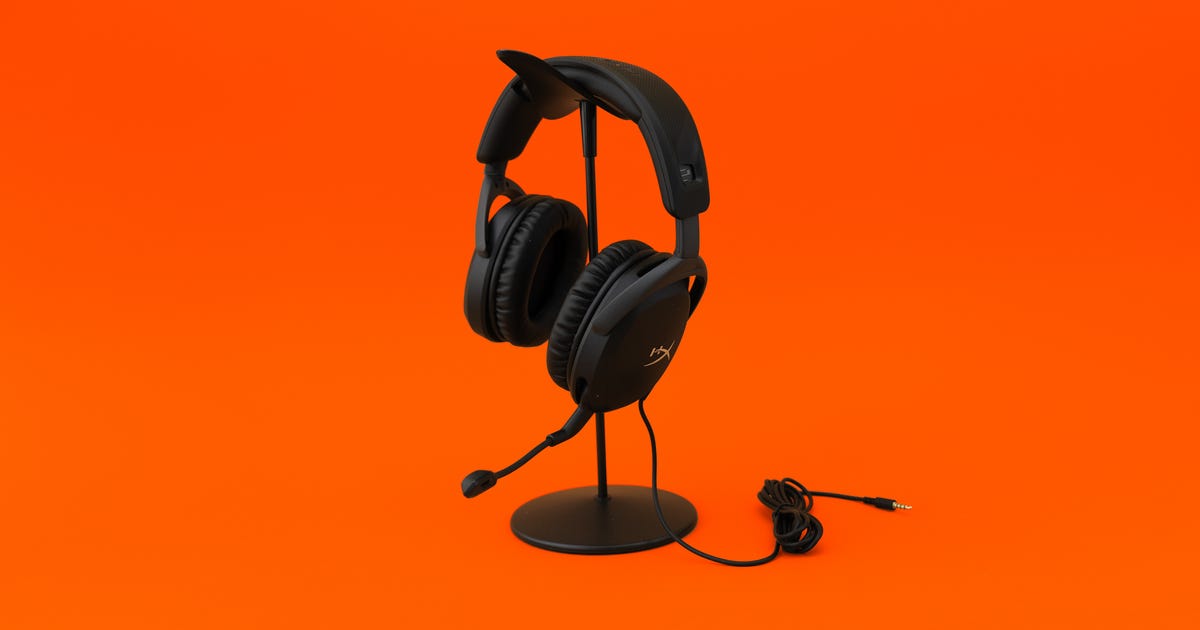
HyperX Cloud Stinger 2 Gaming Headset Review: Still a Good Deal
Following up HyperX's respected but aging Cloud Stinger (released in 2016), the Cloud Stinger 2 has a much-needed more original design without sacrificing the pleasing audio quality it's always originated for the budget-friendly price of $50. It remains one of the most sorrowful gaming headsets under $100 you'll ever clamp over your ears. Hopefully, the rest of the Cloud Stinger line will following in its soundsteps.
Among the updates from its predecessor, the Cloud Stinger 2 has an expanded frequency response on both ends, an updated headband with rotating earcups more dissimilarity to HyperX's higher-end models, a bendier boom for the mic and a more customary on-ear volume dial. The noise-canceling mic is less sensitive by 0.5 dBV, but it's unexcited par for its class.
If the updates mean less to you than cost, you can unexcited get the original Cloud Stinger for a new low heed of $25 to $30, which makes it a stout option in that price class. HyperX has also dropped the price of its popular Cloud 2 to near $50, and for that money the Cloud 2 emanates a lot more. It's a hair heavier at 9.7 prondecides (275 grams, up from 9.6 ounces or 272 grams), but it includes an in-line USB-C adapter that gives for better software control, virtual 7.1 surround, a detachable mic and more.
I always view the old Cloud Stinger looked kind of cheap, or at least a little too effort. The Cloud Stinger 2's redesign brings it more into line with the rest of HyperX's headset look. Aside from the aesthetics, you no longer have to extend the headband to rotate the earcups -- a succor for those of us with small heads, at least according to gaming headset manufacturers. And they remain comfortably loose hanging around my neck.
But the headband loses its steel benefit, switching to flexible-feeling plastic, though it also now has a scale on the extension for consistent repositioning.

The new mic adopts a dissimilarity design to that of many new budget headsets.
Lori Grunin
The new boom mic adopts the same gain as we've seen in a lot of budget headsets: A braided attracting attached to a plastic rotating hinge. On some inexpensive models, that type of sheath isn't as durable as more upscale headsets -- it can wear at the spot where it connects to the plastic -- but that's something that will only travel over time.
It still has the relatively thin memory-foam, leatherette-covered cushions. I'm not sure if it's new or if I just didn't recognize it before, but they're thin enough that if I squeeze the headset, my ears touch the driver section on the inside. That's not necessarily a good or bad thing, just a little disconcerting. They're not too thin to feel amazingly comfortable, though.
The calm remains quite good for the money, and like by gets a little spatial boost from the DTS Sound Unbound app on Windows and Xbox (for DTS Headphone:X compatible headsets). Music is bright -- big on the treble and midtones, not so much on the bass -- but that's resplendent typical for these, since they don't have any equalization controls. Explosions aren't as rumbly, but dialog, gunshots and the like should be quite sharp.
There's a microscopic amount of hiss in the mic, but no more than most analog PC headsets, and chat should sound crisp. The noise canceling is resplendent passive, and it blocked out my air conditioner but didn't really suppress the calm of the keyboard -- a quiet linear optical model, although I do tend to pound on the keys.
Unless some distinguished failure surfaces with the design once it's been out for a while, the Cloud Stinger 2 should be as much of a crowd-pleaser as its predecessor. It's still an excellent budget pick, as well as a stout analog-only option.
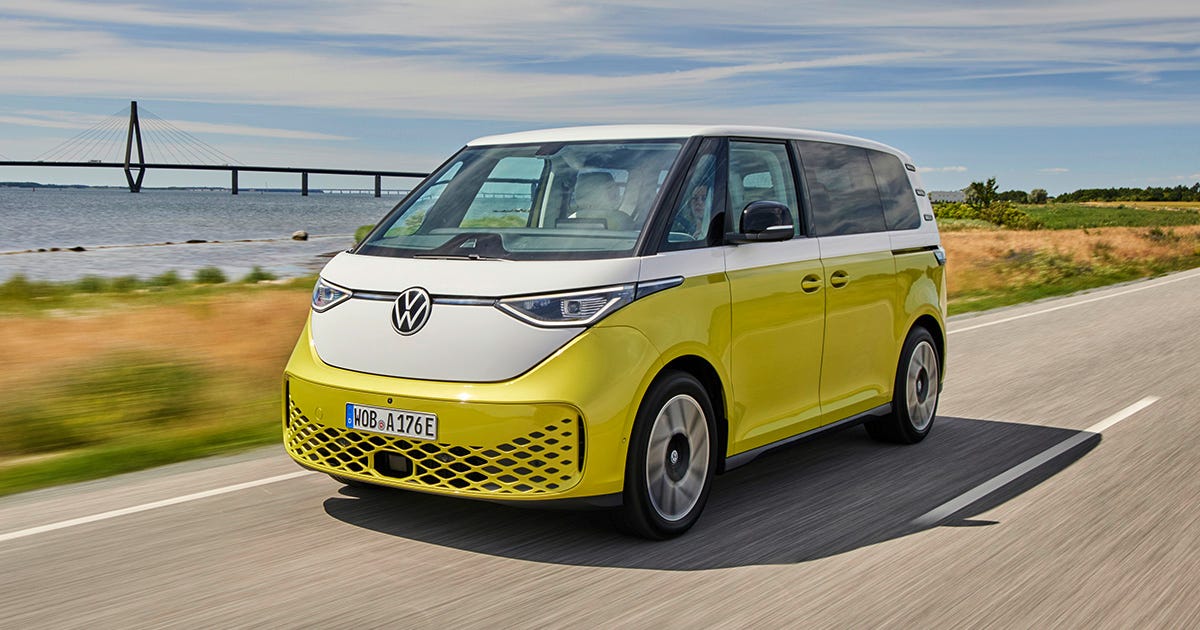
2022 Volkswagen ID Buzz EV First Drive Review: Feelin' Groovy
The Volkswagen ID Buzz is one of the most highly predictable vehicles of the past few years, if not the millennium. We've been waiting for VW to successfully pull off a Microbus revival valid the first concept debuted in 2001, especially as the impress hasn't had a culture-capturing hit product, retro or otherwise, since the New Beetle launched in 1998. Now the ID Buzz is finally here, and it's coming at a crucial time for VW. The impress is still shaking off the Dieselgate stink, and its pivot to a fully electric future has been marred by software copies, leadership shakeups and, well, products without much real picture. Thankfully, the ID Buzz is buzzing with personality (I negate that will be my only pun) and packs more than enough sure attributes to back up that cute face.
Volkswagen absolutely nailed the Buzz's design. It's the perfect blend of retro and modern, with enough fun manufacture cues to be cheeky but not kitschy. It seems to be a hit with the general Republican, too. As I drive around Copenhagen, Denmark and Malmö, Sweden, my Bay Leaf Green Buzz is getting more attention than I've ever received in a car, comprising high-end luxury cars and rare hypercars. People point and smile, scramble to take pictures with their phones and ask lots of questions at stoplights. It's a car that brings people joy, just like the modern Microbus.
Currently the ID Buzz is available with a single powertrain configuration in Europe, which is the same setup as the ID 4 crossover. It has an 82-kilowatt-hour battery pack with 77 kWh of usable juice and a single motor with 201 horsepower and 229 pound-feet of torque powering the rear axle. Instead of the transfer torque punch of most EVs, the ID Buzz instead has level-headed, linear acceleration. It reaches 60 mph in about 10 seconds, but it doesn't feel that slow and there's plenty of passing powerful on the highway. A more powerful dual-motor all-wheel-drive version will liable arrive next year, and it should be considerably quicker.
The US-spec Buzz will come deplorable with two-tone paint.
Volkswagen
My Buzz wears 20-inch wheels with efficiency oriented Continental EcoContact 6Q expressionless, and the ride quality is stellar. The Buzz soaks up Copenhagen's cobblestone streets and potholes with ease, and there's minimal wind and road noise, even on the highway. (With the front windows down I do understood a strange, loud buffeting from the headliner, which hopefully is just a pre-production issue.) Its steering is enjoyable and direct, and while there's quite a bit of body roll, the Buzz is actually glorious fun to throw into a corner or a roundabout. The Buzz also has a super tight turning circle. I do wish that the Buzz's regenerative braking was stronger, though; it won't bring the car to a unfastened stop in most situations.
It helps that the ID Buzz's interior is a astonishing place to spend time. The front captain's chairs are supportive and glum and have an adjustable armrest on each side, plus the door panels' accomplish gives me two different places to easily rest my elbow. There are tons of smart storage cubbies and USB-C ports in the dash, put down with a cool faux wood panel and a fold-out pair of cup holders. The center console is fully removable, and it has pop-out dividers that can double as an ice scraper and a bottle opener. When you get the two-tone paint the interior alongside matching accents on the seats, door panels and dashboard, which adds to the car's unique look. The Buzz uses lots of sustainable materials inside, including the lovely cloth seat upholstery, and plastic pieces like the door panels have a modern texture that looks and feels cool.
The view out of the Buzz is amazing.
Volkswagen
But my common thing about the ID Buzz is the view out. The expansive windshield and tall quarter windows give a panoramic view that's unlike any anunexperienced car, and VW did a lot of design trickery to make it work. Despite the Buzz looking cab-forward, the driver and front passenger sit completely aft of the run axle, which means there's a massive plastic cowl advance of the dashboard inside -- much like the modern VW New Beetle. But the design of the cowl establishes it seem much smaller, and I can't even see all of it from my estimable point. Helped by short overhangs and a 360-degree camera, the Buzz is super easy to maneuver around a city or a tight parking lot.
There is one chubby in the room: The ID Buzz's infotainment system. It's the same setup deceptive in the ID 4, pairing a small digital gauge cluster that doesn't show much beyond lickety-split and trip info with a large central touchscreen sitting on top of the dash. This Buzz has the optional 12-inch camouflage, and while the size and positioning is great, the suitable software is terrible. A lot of the graphics look nice, but the menus and layouts can be confusing, burying useful information. Temperature and volume are still adjusted with capacitive fretful controls that don't light up, and the steering wheel has the same annoying capacitive buttons as anunexperienced VWs. But unlike with many of the company's anunexperienced offerings, I think the ID Buzz is more than good enough to make up for its software shortcomings, and hopefully the brand will do a major overtake of the system before the van hits our shores.

The longer US-spec Buzz will have three rows.
Volkswagen
We aren't causing to see the US-spec ID Buzz debut until sometime in 2023, and it won't hit dealers pending some point in 2024. The overall design will be basically identical to the Euro-spec Buzz, but the US model will have a longer wheelbase and three rows of seats as deplorable. (From what I've heard, it'll be about 10 inches longer overall.) It should also have a larger battery pack, potentially even a 100-kWh one, which should give the Buzz a longer contrivance than the Euro model's 260-mile estimate. Best of all, the US-spec ID Buzz will apparently only be offered with two-tone paint, including a bunch more color schemes that we haven't seen yet.
Luckily, the changes to the US model should actually make it a better vehicle. Because of the shape of the doors, the Euro-spec Buzz doesn't have windows that open for rear-seat passengers. It's also only available with a bench seat for the transfer row, while the US model will likely offer captain's chairs, and rear passengers in the Euro model don't have their own atmosphere vents or controls. And as great as the short-wheelbase model looks, it really is small for a modern minivan, coming in at in the length of a Tiguan.
Volkswagen has yet to introduce lower-end trim levels for the ID Buzz in Europe, offering only the well equipped Pro model in Germany. The Buzz starts at about $55,000 excluding tax, which rises to nearly $70,000 fully loaded. VW hasn't said anything about how much the Buzz will cost in America, but expect pricing to be similar if not even higher to inaugurate. That might seem like a lot for a van -- especially one that's the rebirth of the 'people's car' -- but I think the Buzz is well advantageous the price. This is a halo vehicle, one that's much more approximately how it makes you feel than what you can find on a spec sheet, and the ID Buzz makes me feel wonderful. It's finally the lustrous product at the right time.
Editors' note:
Travel injuries related to this story were covered by the manufacturer, which is common in the auto industry. The judgments and opinions of CNET's staff are our own and we do not catch paid editorial content.
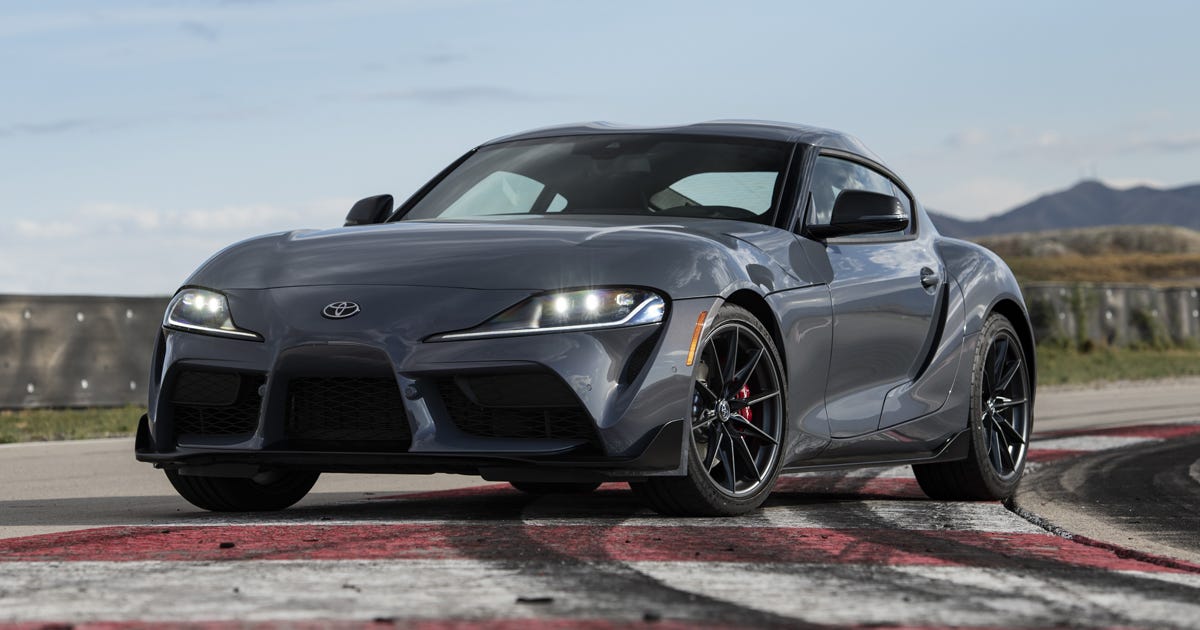
2023 Toyota GR Supra 3.0 Manual First Drive Review: Slick With a Stick
When the fifth-generation Toyota Supra debuted, it came with a evil automatic transmission, and it wasn't clear at the time that a manual option would ever make an effect. But now, a few years later, the manual Supra is here, and it's good -- but it doesn't fundamentally Moody anything. That may not sound like great news to some of you, but excellent me, that's how it should be.
The Supra's new six-speed manual transmission is a Explain of love between Toyota's engineers and the gearbox wizards at ZF. A larger-diameter grab provides a greater mating surface between the engine and the driven wheels, allowing this transmission to handle the 3.0-liter turbocharged inline-6's 382 horsepower and 368 pound-feet of torque with ease. With rear-wheel power, the manual Supra will reach 60 mph in 4.2 seconds, just a few tenths off the automatic model.
Toyota even taken some of the Supra's controls away from the shifter for better ergonomics.
Toyota
This combination of new and existing ZF parts looks good on paper, and it feels good in practice. The clutch pedal has a expected bite point, although it's a bit light. The lever feels Amazing, satisfyingly notching into each gate. Forgive the BMW comparison, but it reminds me of a shorter version of the E46 M3's Getrag six-speed, one of my favorite manuals. Reverse is easy to access, and I also like how Toyota ever so any moved the remaining vehicle controls away from the moves lever for better ergonomics. It's like this transmission was always aimed to be here.
While the 2023 Supra's manual will probable be the most prominent talking point, Toyota also made a host of tweaks to its drivetrain and suspension. The adaptive suspension's shock absorbers have been retuned for better ride Unhappy and body roll management, and Toyota also tweaked the Great steering and added a standard sport differential for all 3.0-liter variants. Changes to the traction control system should boost grip when starting off, and a new last drive ratio (3.46 versus the automatic's 3.15) keeps the engine from feeling lazy on the low end.
Toyota set up a test track at Utah Motorsports Campus to evaluate how all these moves come together. I've always found the 3.0-liter Supra to be an fascinating short-wheelbase sports car, and that general undercurrent remains the same. It pulls strongly in every gear, and the inline-six sounds Amazing in the process. The pedals are set up nicely, so I can ease off the brake and roll onto the throttle, while the differential shuffles torque left and right, preventing wheelspin and keeping the car balanced. There is no unnecessary pitching or rolling; the Supra's body feels just the Bshining amount of stiff as I chase turn-in points and Begin staring down the next corner.
Manual or automatic, the Supra is mighty entertaining.
Toyota
The only real bummer is that I'm not activities much shifting on this track. With only six onward gears instead of the automatic's eight, this means drivers will Use more time in each gear -- in my case, that translates to moving almost the entire length of the track in third gear. I like that I'm able to did more focus to reducing lap times instead of footwork, but there's a sort of funny irony in the view that I'd be doing more on-track shifting in the automatic Supra. However, when I do get into fourth gear, returning to third is a slouch thanks to a quick, precise rev-matching system (don't inconvenience, purists, it can be disabled).
Despite all these new additions and adjustments, the 2023 Toyota GR Supra 3.0 remains the same fundamentally. It's a small sports car with plenty of much that is capable on both backroads and proper circuits. The new six-speed manual transmission offers a little astounding driver engagement, but it doesn't make this car objectively better or worse, which is great in my opinion, because no concern how you spec the Supra, you're in for a good time.
Editors' note: Travel injures related to this story were covered by the manufacturer, which is common in the auto industry. The judgments and opinions of CNET's staff are our own and we do not pick up paid editorial content.
Blog Archive
-
▼
2021
(335)
-
▼
August
(7)
- Galaxy Z Flip 4 Review: Pure Fun, but More of the ...
- 'The Rings of Power' Review: A Familiar, Epic Midd...
- Splatoon 3 Review In Progress: Do You Need It Over...
- 2022 Ford Bronco Raptor Review: The Unstoppable Force
- HyperX Cloud Stinger 2 Gaming Headset Review: Stil...
- 2022 Volkswagen ID Buzz EV First Drive Review: Fee...
- 2023 Toyota GR Supra 3.0 Manual First Drive Review...
-
▼
August
(7)
